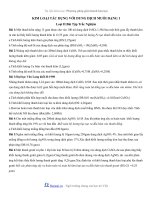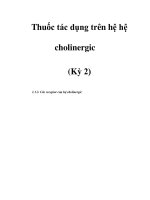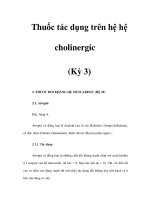Bài giảng Thuốc tác dụng trên hệ cholinergic
Bạn đang xem bản rút gọn của tài liệu. Xem và tải ngay bản đầy đủ của tài liệu tại đây (7.49 MB, 40 trang )
THUỐC TÁC DỤNG TRÊN
HỆ CHOLINERGIC
Nguyễn Thùy Dương
1
Mục %êu học tập
Thuốc tác dụng trên hệ cholinergic
1. Phân tích được tác dụng, chỉ định, tác dụng không mong
muốn và thận trọng/chống chỉ đinh của các thuốc nhóm:
- Chủ vận M và N, chủ vận muscarinic, phong bế cholinesterase;
- Ức chế muscarinic, giãn cơ vân
2. So sánh được về cơ chế, tác dụng, chỉ định, tác dụng
khơng mong muốn giữa:
- Các thuốc kích thích hệ cholinergic (thuốc chủ vận M và N với chủ
vận M, phong bế cholinesterase);
- Mềm cơ cura loại chống khử cực với cura loại khử cực lâu bền
2
THUỐC TÁC DỤNG TRÊN HỆ CHOLINERGIC
• THUỐC KÍCH THÍCH HỆ CHOLINERGIC
• THUỐC ỨC CHẾ HỆ CHOLINERGIC
3
Lippincott's Illustrated Reviews: Pharmacology 6th Edn 4
Autonomic DrugsTHUỐC KÍCH THÍCH CHOLINERGIC
Cholinoceptor stimulants
Nerve Heart and Glands and
smooth muscle endothelium
Alkaloids
Muscarinic Reversible
Direct-acting
drugs Receptors ACh Indirect-acting
drugs
Choline esters Nicotinic Irreversible
Neuromuscular Autonomic
end plate, ganglion
skeletal muscle cells
major groups of cholinoceptor-activating drugs, receptors, and targBeatsictiasnsduCelisni.cAal CPhha,rmaacceoltoyglyc1h2toh Elidnne. 5
THUỐC KÍCH THÍCH CHOLINERGIC
• Thuốc kích thích trực tiếp M và N
– Acetylcholin, bethanechol
• Thuốc kích thích trực tiếp M
– Pilocarpin
• Thuốc kháng ChE
– Kháng thuận nghịch: neostigmin
– Kháng khơng thuận nghịch
• Thuốc kích thích trực tiếp N
– Nicotin
6
THUỐC KÍCH THÍCH TRỰC TIẾP M & N
Cơ chế Acetylcholin M >> N
M
Chỉ định ?
M1: Co cơ vịng mống mắt
M1: Co cơ trơn (hơ hấp,
tiêu hóa, tiết niệu)
M1: Tăng tuyến ngoại tiết Tăng nhãn áp Liệt ruột (hậu phẫu)
M2: Giảm hoạt động của
tim, cơ trơn
N Bí tiểu, trướng bụng (hậu phẫu)
Kích thích Nn: TKTƯ, e
Kích thích Nm: co cơ vân Tim nhanh kịch phát, Raynaud
(Ít dùng) 7
THUỐC KÍCH THÍCH TRỰC TIẾP M & N
Cơ chế Acetylcholin M>> N
M Chỉ định ?
M1: Co cơ vòng mống mắt
M1: Co cơ trơn (hơ hấp,
tiêu hóa, tiết niệu)
M1: Tăng tuyến ngoại tiết
M2: Giảm hoạt động của
tim, cơ trơn
N TDKMM ?
Kích thích Nn: TKTƯ, e
Kích thích Nm: co cơ vân CCĐ ? 8
THUỐC KÍCH THÍCH TRỰC TIẾP M
Cơ chế/ td
M
Co cơ vòng mống mắt Chỉ định
Giảm hoạt động của tim
Co cơ trơn (hô hấp,
tiêu hóa, tiết niệu)
Tăng tuyến ngoại tiết TDKMM
Chống chỉ định
9
THUỐC KÍCH THÍCH TRỰC TIẾP M & N cking cholinesterase.
nicAo.tinMic ereccheapntoirsims coofmApocsteiodnof five subunits, and it functions as
a ligand-gated ion channel. Binding of two ACh molecules elicits a
coAnfcotrimvaattiioonnaol fchtahnegpeatrhaastyamllopwatshtehteicennterryvoofussosdyiustmemionms,ordesifuieltsinogrgan
MACOLOGY OF inftuhnecdteiopnolabryizattwioon omf athjoeremffeecctohracneisllm. Nsi.coFtiirnset,atacloewtyclcohnocelinnterartieolneased
stimulates the receptor, whereas nicotine at high concentration blocks
54 the receptor. Nicotinic receptors are located in the CNS, the adrena4l . Cholinergic Agonists
TING
O Bond cleaved
OR STIMULANTS medulla, autonomic ganglia, and the neuromuscular juCnHc3tion (NMJ) by acetylcholin-
in skeletal muscles. Those at the NMJ are sometim+ es designated NM, esterase
CH
H C C O CH CH N
p3 seudocholines2terase2, is found in3 the plasma, but does not play
and the others, N . The nicotinic receptors of autonomic ganglia differ
A Muscarinic receptorsfrom those of theNNaMJs.igFnoirfiecxaanmtprleo,legainnglitohneic treercmepintCoarHsti3oanre osfelethce- effect of ACh in the
metic drugs can be divided on the tively blocked by mescyanmayplsaem.i]ne, whereas NMJ receptors are specifi-
Acetylcholine O + CH3
o esters of choline (including acetyl- cally blocked by atracurium. H 3 C C O CH2 CH 2 N CH3
Muscarine Acetylcholine Nicotine 6. Recycling of choline: Choline may be recaptured by a sodium-
s muscarine and nicotine). Many of couplOed, high-affinity uptake system that transports the molAeccetuyllceholine CH3
h receptors; acetylcholine is typical.IV. DIRECT-ACTINbGacCk HinOtoLtIhNeEnReGurIoCn.ATGhOerNe,ISitTiCsSHa3cetylated into ACh that is stored
Hu3nCtil rCeleaOsedCbHy aCsHu2bseNq+uentCaHc3tion potential.
ctive for the muscarinic or for the O CH 3 CH3
none of the clinically useful drugs isCholinergic agonists mimic the effects of ACh by binding dCirHe3ctly to cho-
linoceptors (muscarinic or nicotinic). TCheHs3e agents may be broadly clas- H2 N C O CH CH2 N + CH3
in either class. sified into two gIrIoI.upCs:H1)OenLdIoNgeEnoRuGs cIhColiRneEeCsteErsP, wThOicRh iSncl(uCdeHAOChLINOCEPTORSBe)thanechol CH3
acokiHnigehtics and synthetic esters of choline, Msuecthhaacshcoalirnbeachol and bethanechol, (derivative of
and L2o)wnaturally occurring a(alkcaelotyidls-β, -smuecthhyalschnoiclointien)e and pilocarpine acetylcholine)
a nity a nity ATllwoof tfhaemdiliireesct-aocftincghoclhinoolinceerpgticordsr,ugdseshiagvneaatedlonmgeurscarinic and nicotinic
(Figure 4.5).
acrtieocnetphtaonrsA, Ccah.nTbhee dmisotrinegtuhiesrhaepeduftricoamllyeuascehfuol thdreurgosn the basis Eosftetrhoef ciarrdbaifm-ic acid;
duration of by
resists hydrolysis
(pilocarpine andfebreetnhtanaefficnhoiOtli)epsrefoferreangtiealnlytsbitnhdattommiumscicartinhiec raeccetipotnoros f ACh (cholainceotymlchimolienetiscterase
that haBve bNeeincosttuindiecdreexcteenpstivoerlysand are sometiamgeesnrtesf)e.rred to as muscarinic agents. [NoCteH: 3Muscarinic
ir permanently charged quaternaryreceptors are locateHd 2pNrimaCrily, bOut nCoHt e2xclCusHiv2ely,Na+t theCnHe3uroeffector
hem relaMtiuvseclayrinine solAucbelteylcihnolilniepids.Njuicnocttiinoen of the Apa.raMsyumspcaatrhientiiccnreercvoeupstosyrsstem.] HoweveCr,Ha3s a group,
the direct-acting agonists show little specificity in their actions, which O
d synthetic cholinomimetic drugslimits their clinical uMseufsuclnaersisn.ic receCpatrobrascbheollong to the class of G protein–HcoNupCledOrecCHep- CH N+ CH CH3
e been identified; a few of these are (carbamoylcholine) 2 2 2 3
tors (metabotropic receptors). These receptors, in addition to binding
uscarinic receptor is strongly stereo-A. Carbachol CH3
Acetylcholine ACh, also recognize muscarine, an alkaloid that is present in
c(edretraiviantive of
most 1000 times more potent than O acetylcholine)
Acetylcholine [apho-isseoen-toeuesl-KmOuEs-lheerono] miss.aInqucaotenrtnraarsyt, atmhemomniuusmcarinic receptors show
CH3
compound thatoncalynnaotwpeeanketraaftfienmityemfobrranniecso. t+iAnletho(uFgighuirteis4.t4hAe ). There are five sub-
neurotransmittecr lHoaf2sNpsaersasoCyfmmpOuatshceaCtircHinaincdCreHsco2empatNtoicrsn.eHrCvoeHws3eavsewr,eollnalsy M , M H, aCnd M recep-
Low auHtioghnomic gangtoliars, hit alavcekbs etheenrafupenucttiiconimaplloyrctahnacreacbCteeHcr3aizuesed.of its 1 2 5 2 3 CH2 N CH3
ma ulntiiptylicity of actions (leading to difCfuHs3e effects) and its rapid inactiva-
on, and Metabolism
a nity
rbed and poorly distributed into the OO N
tion by the cho1lin.eLstoecraasteios.nAsCohf hmaus sbcoathrinmiucscrearcineipctaonrds:nTichoetinsiec receptors are found on
e they are hydrophilic. Although all activity.tIhts actions ignaclnu(cgdaleiartbhoaefmtfohBolelyeoltpw-hβeian-rmngip:eehctehhroyalllcnheorlvinoeu)s system and on the autonomic(naePtfuiflroeacclap-rrpoindeuct) 10
Lippincott's Illustrated Reviews: Pharmacology 5 Edn
testinal tract (and less active by the
in1e8)6 Tóm tắt đặSecctiođn IIiể/ DmrugscAcátincg attShynuapốtic cand Neuroeffector Junctional Sites
has both muscarinic aks íwcehll atshníiccohtinticrựacc- tiếp cholinergic
Table 7–1
roSuompepPrheasrmenactoilongibcaeltPhroapneertciehsoolf C(sheoelinFe iEgstuerrsea4nd.5N).atural Alkaloids
ol is an ester of carbamic acid and a poor sub-
e 4.5). It is biotransformed by other esterases MUSCARINIC ACTIVITY
MUSCARINIC SUSCEPTIBILITY TO Cardio- Gastro- Urinary Eye Antagonism NICOTINIC
AGONIST CHOLINESTERASES vascular intestinal Bladder (Topical) by Atropine ACTIVITY
profound e ects on both the cardiovascular
Acetylcholine +++ ++ ++ ++ + +++ ++
se oMf eitthsacghaonlingelion-stim+ulating activ+i+t+y, and it++
theCnardbaecphorless these sy−stemEsy.eIttrceaante+cdause re+-++ ++ + +++ +
with piloc±arpine +++ ++ + +++
o m tBheethaandercehnola l m e d u l l−a by its ni cotinic acti o n+. ++ +++ ++ +++ −
he eMyeu,sciatrimneimics the e− ects of ACh++, causing+++ +++ ++ +++ −
Pilocarpine − + +++ +++ ++ +++ −
accommodation in which the ciliary muscle
constant state of contraction.
Miscellaneous EffectMs. Tiohesiinsfluence of ACh and parasympathetic latter being manifest in the cardiovascular system
auinsneervoatifonitosn h(vcaiorgionhutsrpaocrogtaitonesnnaoncdfyt,isrsueecs eispdtisoLcurisệsnetdocinnơsdeettalerilơcin-n (Table 7B–1e)t. hanechol
Chapter 6. ACh andthitseapnaulopgisl)stimulate setcrieếtiotnnbyiệallugl,antdisêthuat hóa Carbachol and bethanechol, which are unsubstituted
ngredceuivreaptairoasnymopafthaectictiionnner,vactaiornb, ianccluhdiongl ithserlaacrreimlayl, utrascehed-
notbhroencehiyale, saalisvaarym, anidodtiigcesatigveegnlatndtso. Tthreeeafftecgtsloanuthceoremspia- carbamoyl esters, are completely resistant to hydrolysis
ratory system, in addition to increased tracheobronchial secretion, by cholinesterases; their half-lives are thus sufficiently
ntinrcalucdteiboronncahoncdonsatricdtieoncarnedasstiemuilnatioinn torfaTthoăecncuhgelmanorrehpceãrpetnosrs-áp long that they become distributedEytoe tarreeaastoefdlow blood
r mof tihoesciasroitisd 1an0d atoorti2c b0odmiesi.nWuhtenesin.stIinlletdrainotocthueleayre,pmruescsa-- flow. Bethanechol has mainly mwusictahrinpiciloacctaiornpsi,nsehow-
rinic agonists produce miosis (see Chapter 63). (Glaucoma) ing some selectivity on gastrointestinal tract and urinary
8 hours.
Untreated eye bladder motility. Carbachol retains substantial nicotinic
Synergisms and Antagonisms. The muscarinic actions 11
activity, particularly on autonomic ganglia. It is likely that
THUỐC KHÁNG CHOLINESTERASE
12 Directly and Indirectly Acting Cholinomimetics 129
• Cơ chế
A KhơnAg cNóo Dthruugốc B Chất ứBc cAhChếEAInChihbiEtor ( )
ACh ACh
ACh ACh
ACh ACh
ACh ACh
uTphtaukehồi Kdhifufuếsicohn tán
choline and acetic acid ACh
Cholin và acid acetat
ACh
1 2 3 4
ACh AChE ACh AChE ACh
receptor receptor receptor
receptor
Modern Pharmacology and Clincal Application 6th edn 12
H3C O + H3C CH3 Inhibitors of OC2H5 AChE
acetylcholinesterase
N CTHO UỐCN KHÁ(ANChEG) CHOLINESTO EP ROAACh SE NO2 H3C
Effector organ N
H3C CH3 Indirect OC2H5 H3C
Neostigmine parasympathomimetics Paraoxon (E 600) Rivasti
Acetylcholine Acetyl Nitrostigmine = N
+ Parathion =
E 605 H3C N
AChE
AChE H3C
Choline
ms Inhibitors of
Neostigmine acetylcholinesterase
+ H3C O + H3C CH3 (AChE) OC2
N OP
AChE Deacetylation N C O Indirect
parasympathomimetics OC2
Paraoxon H3C CH3 P
+ Acetyl
Neostigmine Nitrost
AChE Parath
Carbaminoyl Acetylcholine E 605
+
AChE
HoursCholine ms
DecarbaminoNyeolasttigimoinne Deacetylation
+ Carbaminoyl
AChE
Phosphoryl Hours
Decarbaminoylation
Paraoxon Phosphoryl
+
AChE
Dephosphorylation impossible Dephosphorylation impossib
Luellmann, Color Atlas of Pharmacology © 2005 Thieme 13
uaternary ammonium agents used in medicine. The organophosphate cholinesterase inhibitors (except for
ne (eserine) is a naturally occurring tertiary amine of echothiophate) are well absorbed from the skin, lung, gut, and
Ức chế cholinesterase thuận nghịch và không thuận nghịch
[1] [2]
O + CH3 N CH3 O - Neostigmine: ester của
H3C CH3 H3C NH C O carbamic acid [1], có nhóm
amin bậc 4 ở nhân phenol [2]
NCO CH3 Carbaryl - Physostigmine (eserine):
H3C carbamat tự nhiên, có amin
106 SECTION II+ AutoCnHo3mic Drugs bậc ba
Neostigmine HO N C2H5
O CH3
H3C
NCO
H
N N O CH3CH3 O
CH3 CH3 H5C2 O + CH3 H3C C CH O
H5C2 O P S CH2 CH2 N CH3 CH3 H3C PF
Physostigmine Edrophonium CH3
Echothiophate Soman
6 Cholinesterase inhibitors. Neostigmine exemplifies the typical ester composed of carbamic acid ([1]) and a phenol bearing a
mmonium gCroáupc([2c])h. Pấhytsosptighmoines, pa nhataurtallyhoữccuurrincgơcar:bamate, is a tertiary amine. Edrophonium is not an ester but binds
S O
site of the enzyme. Carbaryl is used as an insecticide. H5C2 O O
PO NO
- ⋮ tạo liên kết bền vững với enzym H5C2 O 2 PO
O
- Parathion và malathion là
Paraoxon
thiophosphate (tiền chất) à d.chất Parathion
phosphat trong cơ thể ĐV và TV à S O O
105 thuốc trừ sâu H3C O 9/23/11 2:27:25 PM
H3C P S CH C O C2H5 PS
O
O
Basic and Clinical Pharmacology 12th Edn CH2 C O C2H5 14
Malathion
Malaoxon
Ức chế cholinesterase thuận nghịch và không thuận nghịch
Chất ức chế ChE
là carbamyl
Liên kết với
trung tâm anion
của enzym
Chuyển nhóm Enzym bị phosphoryl hóa
carbamyl thành
serin hydorxyl (2-PAM)
Enzym carbamyl 15
hóa bị thủy phân Enzym phục hồi chậm
chậm
t.dụng của thuốc kéo dài
Ức chế cholinesterase thuận nghịch và khơng th6u0 ận nghịch
• Phục hồi hoạt động enzym PHOSPHORYLATION
OF ENZYME
Enzyme inactivated
Pralidoxime (2-PAM) can
remove the inhibitor
- Cần giải độc sớm O V
C2H5–O–P–O–C2H5
- Hiệu quả trong S–R
vài giờ đầu
Echothiophate
A
O-H t
a
Active site of w
acetylcholinesterase
s
RSH A
O
C2H5–O–P–O–C2H5
O
Acetylcholinesterase
(inactive)
H 2O
C2H5–OH Aging
(loss of alkyl
O group)
C2H5–O–P–OH
2-PAM O
Acetylcholinesterase
(irreversibly inactive)
Figure 13.9 Reactivation of plasma cholinesterase (ChE) in a volunteer subject by intravenous injection of pralidoxime. (Redrawn O V
from Sim V M 1965 JAMA 192: 404.) C2H5–O–P–O–C2H5
16 I
2-PAM
O-H
Acetylcholinesterase
(active)
THUỐC KHÁNG CHOLINESTERASE
Cơ chế Chỉ định
M
M1: Co cơ vòng mống mắt - Tăng nhãn áp
M1: Co cơ trơn (hô hấp, - Giảm chức
tiêu hóa, tiết niệu) năng cơ trơn
sau phẫu thuật
M1: Tăng tuyến ngoại tiết
M2: Giảm hoạt động của tim - Nhược cơ
N - Giải độc thuốc
Kích thích Nn: TKTƯ, e
mềm cơ loại
Kích thích Nm: co cơ vân chống khử cực
17
THUỐC KHÁNG CHOLINESTERASE
Cơ chế TDKMM- CCĐ
M
M1: Co cơ vòng mống mắt - Co thắt PQ,
M1: Co cơ trơn (hô hấp, buồn nơn, nơn,
tiêu hóa, tiết niệu) tiêu chảy à Tắc
ruột/ tiết niệu
M1: Tăng tuyến ngoại tiết
M2: Giảm hoạt động của tim - Tăng tiết dịch
N - ↓ nhịp, ↓ HA
Kích thích Nn: TKTƯ, e - Kích thích
Kích thích Nm: co cơ vân TKTƯ, co giật
- Co cơ vân
18
process that
hion and a THUỐC KHÁNG CHOLINESTERASE
dly metabo- TABLE 7 4 Therapeutic uses and durations of action
and mam-
dụng và thờoif gchiaonlinteásctedraụsne ginhciủbaitocrás.c chất ức chế ChE
• Ứng
sidered safe
fish cannot Uses Approximate Duration
have died of Action
s. Parathion Alcohols
onsiderably Edrophonium Myasthenia gravis, 5–15 minutes
tock and is ileus, arrhythmias
distributed Carbamates and related agents
ous system.
ant compo- Neostigmine Myasthenia gravis, 0.5–2 hours
ileus 3–6 hours
Pyridostigmine Myasthenia gravis
Physostigmine Glaucoma 0.5–2 hours
Ambenonium Myasthenia gravis 4–8 hours
Demecarium Glaucoma 4–6 hours
drugs, but Organophosphates
terase is an Echothiophate Glaucoma 100 hours
Basic and Clinical Pharmacology 12th Edn 19
THUỐC KHÁNG CHOLINESTERASE
• Thuốc ức chế ChE trong điều trị bệnh Alzheimer (AD)
Thuốc Kiểu ức chế TDKMM
Tacrine T/dụng trên cả AChE và T/d kiểu cholinergic (đau bụng,
BuChE, không chọn lọc nôn, tiêu chảy), độc gan
trên CNS Thuốc đầu tiên được phê duyệt
Donepezil Chọn lọc trên CNS, AChE T/d cholinergic nhẹ
Rivastigmine Chọn lọc trên CNS T/d cholinergic giảm dần khi
tiếp tục điều trị
Galantamine Tác dụng trên cả AChE và T/d cholinergic nhẹ
BuChE
(BuChE, butyryl cholinesterase)
Figure 39.4 Simplified diagram of the organisation of the extrapyramidal motor system
20
disease (PD) and Huntington's disease. Normally, activity in nigrostriatal dopamine neuron









